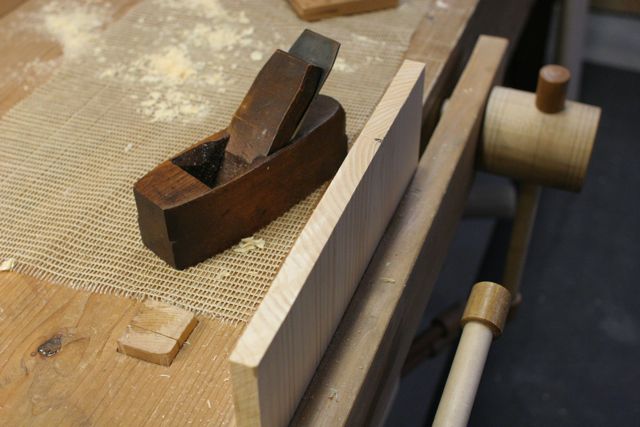We may receive a commission when you use our affiliate links. However, this does not impact our recommendations.
 Is there a secret to planing end grain? Is a low-angle block plane required? I don’t think so. My trusty wooden smoother does a good enough job for me. What you need to plane end grain is a SHARP plane. If that’s your block plane, use that.
Is there a secret to planing end grain? Is a low-angle block plane required? I don’t think so. My trusty wooden smoother does a good enough job for me. What you need to plane end grain is a SHARP plane. If that’s your block plane, use that.
If I had to come up with a secret I’d say I prefer to plane end grain with a plane that has a cambered iron. That way I can square up a hand-sawn end the same way you square an edge with a try plane.
— Adam Cherubini
Here are some supplies and tools we find essential in our everyday work around the shop. We may receive a commission from sales referred by our links; however, we have carefully selected these products for their usefulness and quality.








Gunny Gene, when I sharpen my irons they are only just sharp enough the shave with (I’m too afraid to try them on my face); I’ve found that planing with the direction of the growth rings whenever possible helps quite a bit. I always get more tear-out if I plane across the rings as opposed to along them.
This is a tricky challenge, and I am sure that practice after many mistakes makes perfect. It also pays for your mind to connect with the working surface. Connecting with the tools is discussed at http://www.friendsofwoody.com
I am 66 and very new to woodworking and I am donig my best to soak in as much information as I can.
I have purcheshed three very good planes (lie nielsen), a #4 smoother a # 5 ½ fore and a #7 jioner.
I have built two projects so far (a bench hook and a sawbench (Christopher Schwarz design) and want to build my workbench next.
I am puzzled about end grain. Even on my two “small” projects I had a problem with small pieces of the wood tearing out from the edges.
I have a hand plane book on order from “Woodworking” which I hope will answer this and many other questions I have.
Also are there any good woodworking classes in the Cincinnati Area.
Wouldn’t a steeper grind help?
You’re a lucky man, Caleb. I’d love to own an Old Street plane.
This leads us to the question of how sharp is sharp? I usually get them to the stage where I can shave the hair off my chiny-chine-chine (which looks a little odd for a few days), but still have difficulty with endgrain on various hardwoods even tho I do employ the recommended techniques, etc. that have already been mentioned.
Instead of a brute force frontal assault, it seems to me that a new plane design might be in order which takes into account the physics of the problem. What’s needed is a slicing or sawing action. Any ideas?
I use a plane bedded at 42 1/2 degrees for end grain. I can see and feel a small improvement over 45 degrees. Likewise I think 45 leaves a better surface than 50. A fine surface is helpful for finishing because it takes less finish material to get a good surface; less coats are necessary.
Absolutely right. As for me , I don’t even own a smoother yet but use my 28″ jointer w/ a 50 degree bedded iron because thats what I have. You know what? It works great! (When it’s sharp.)
My experience too. I’ve not found a low angle plane necessary at all. My regular smoother works just fine. In fact, I find that I very rarely even use a shooting board these days, unless a piece is very narrow. As you say, though, the plane does need to be very sharp. I find it helpful to have my knife scribe on all four sides as well in order to have a gauge to plane to when squaring up the cut. I also plane from both edges toward the center.
Thank you for the tip. I will give it a try with my beautiful new little Old Street smoother.
Caleb